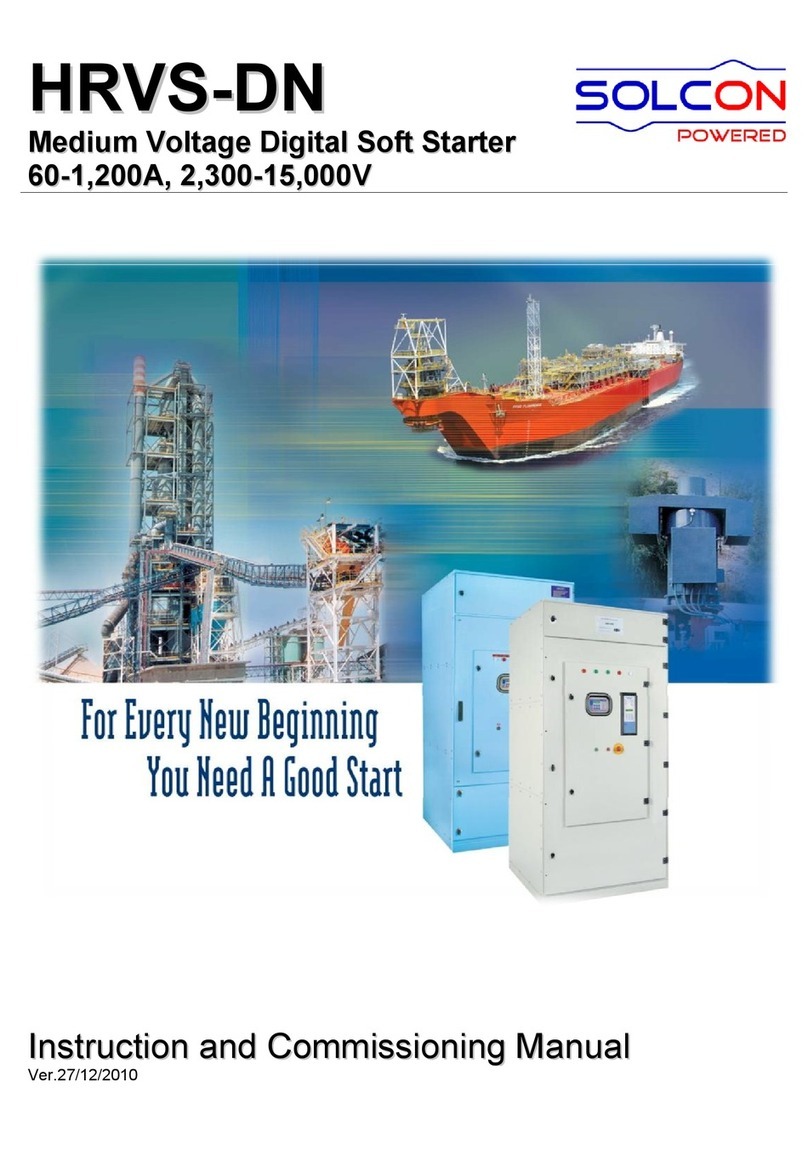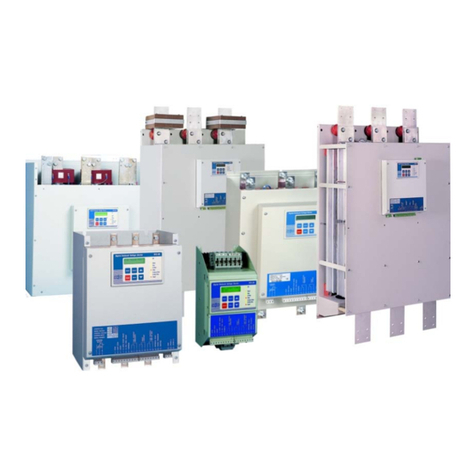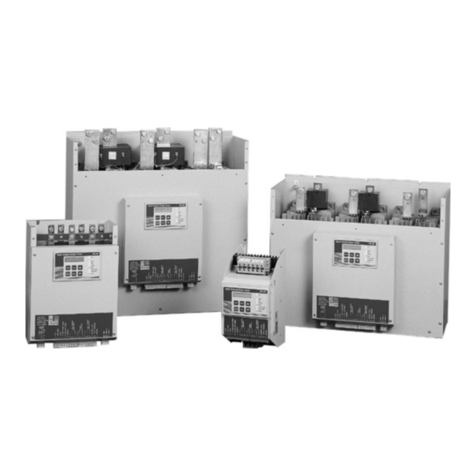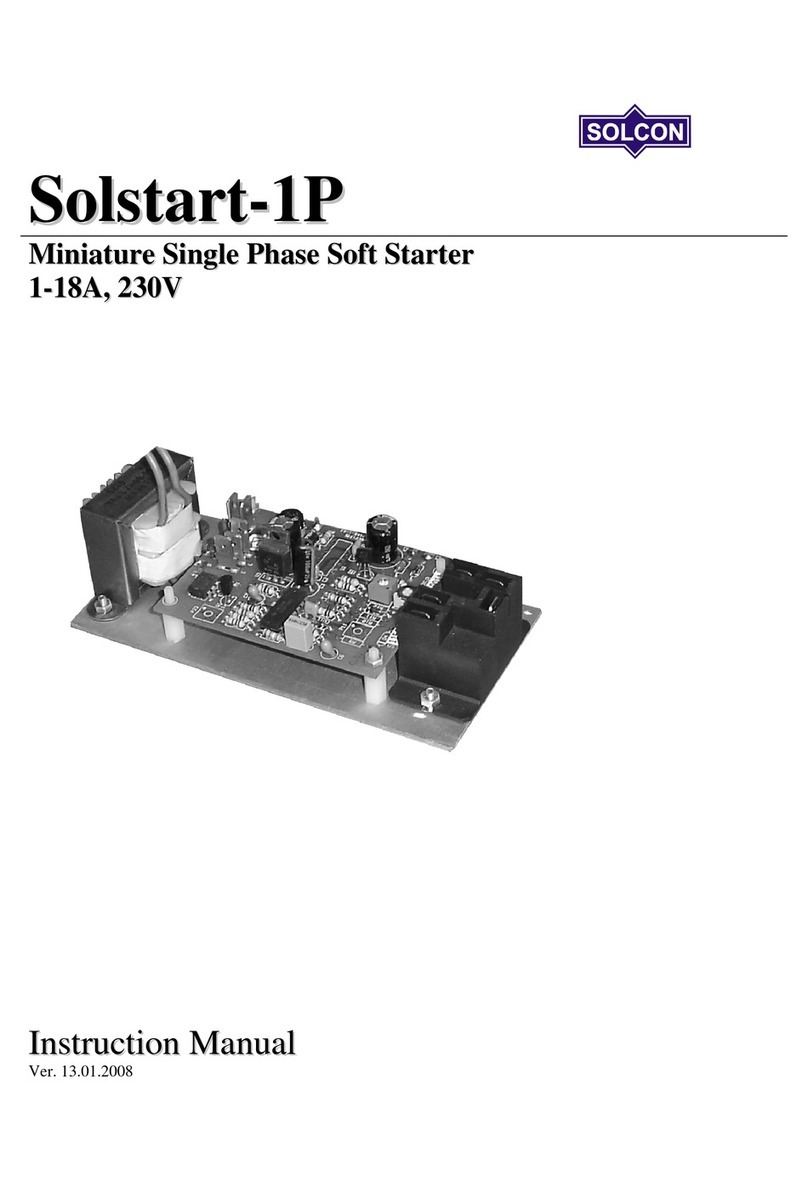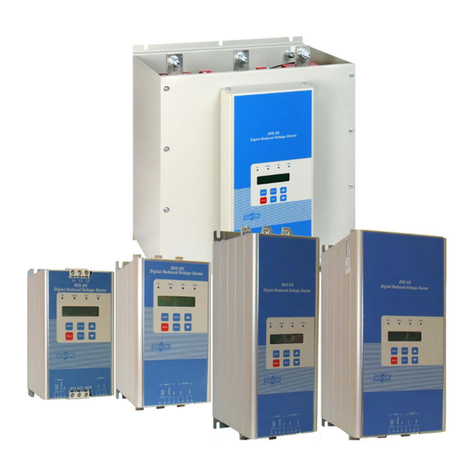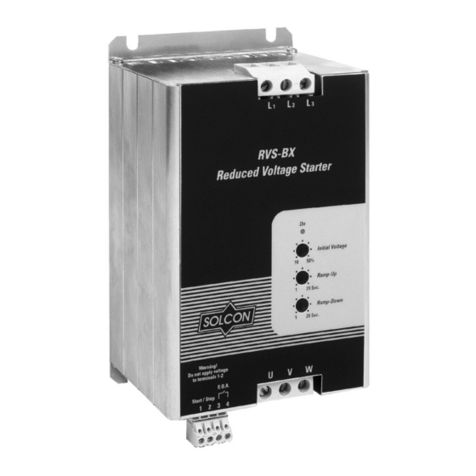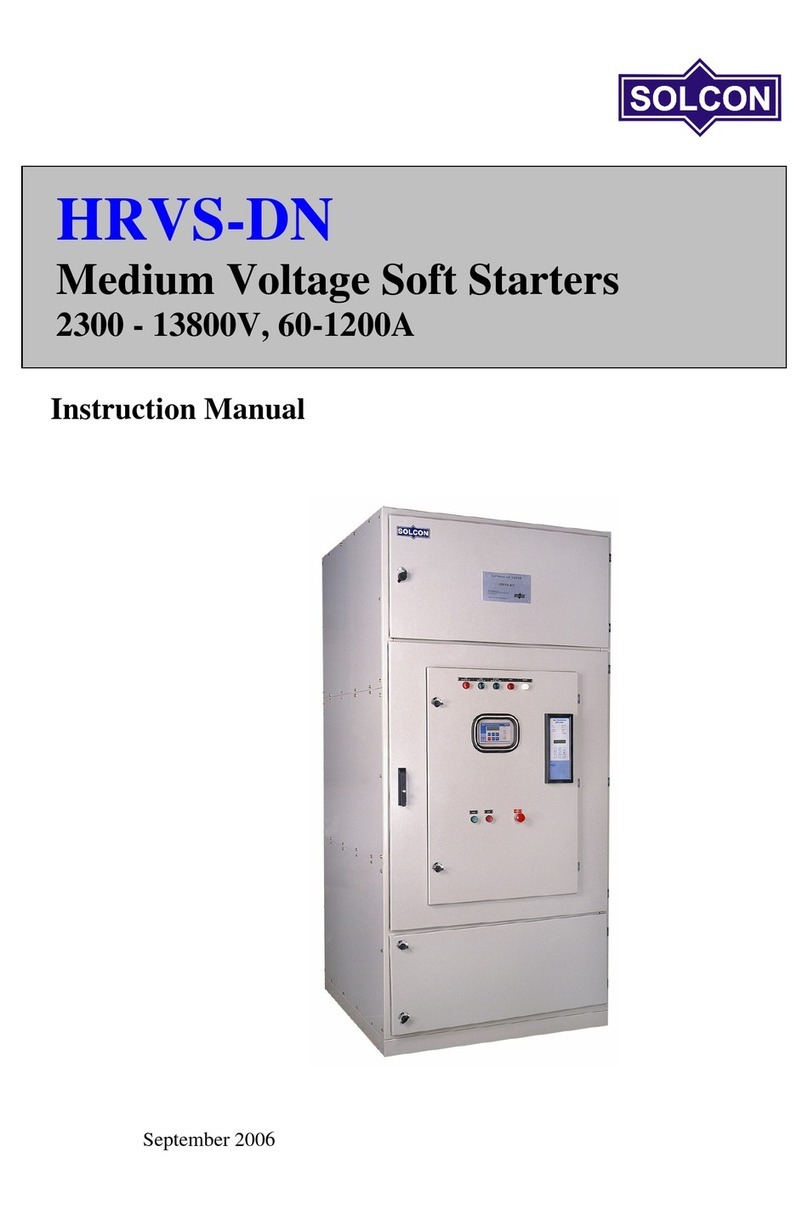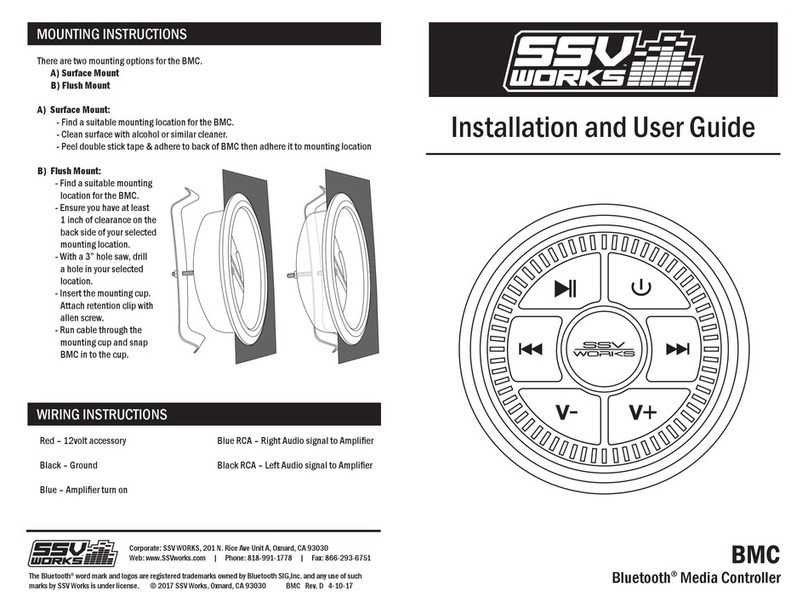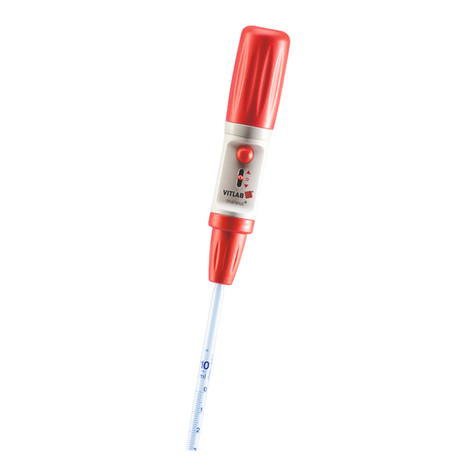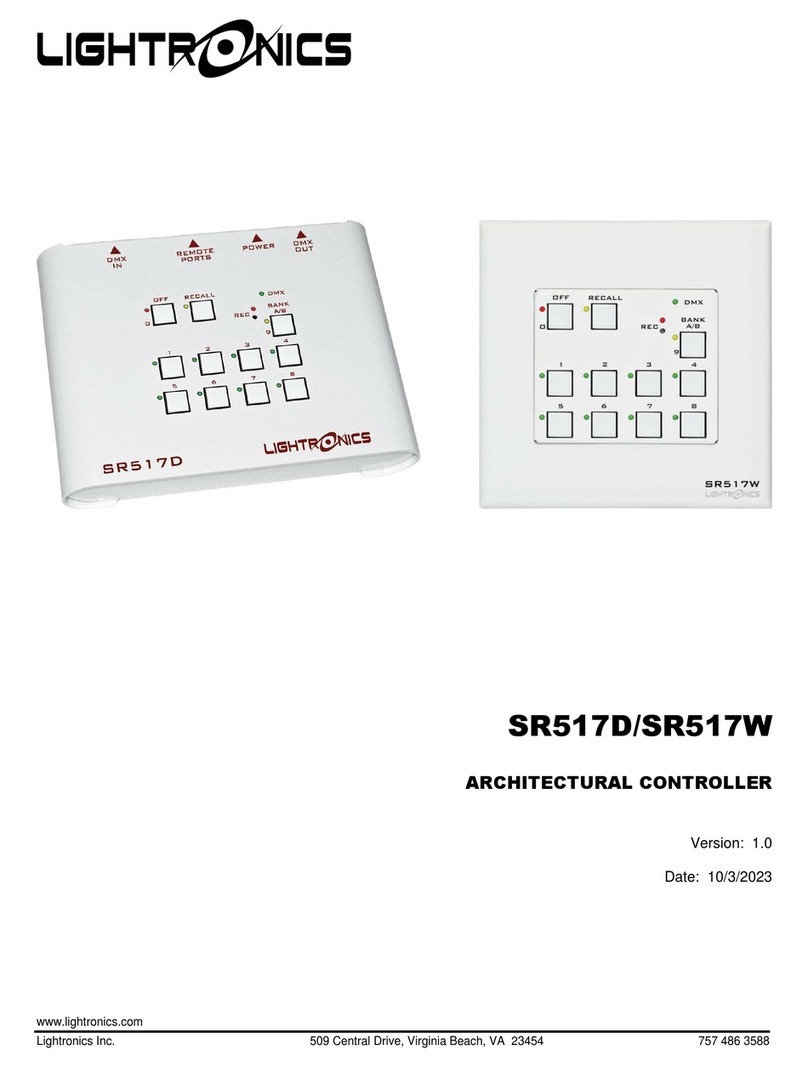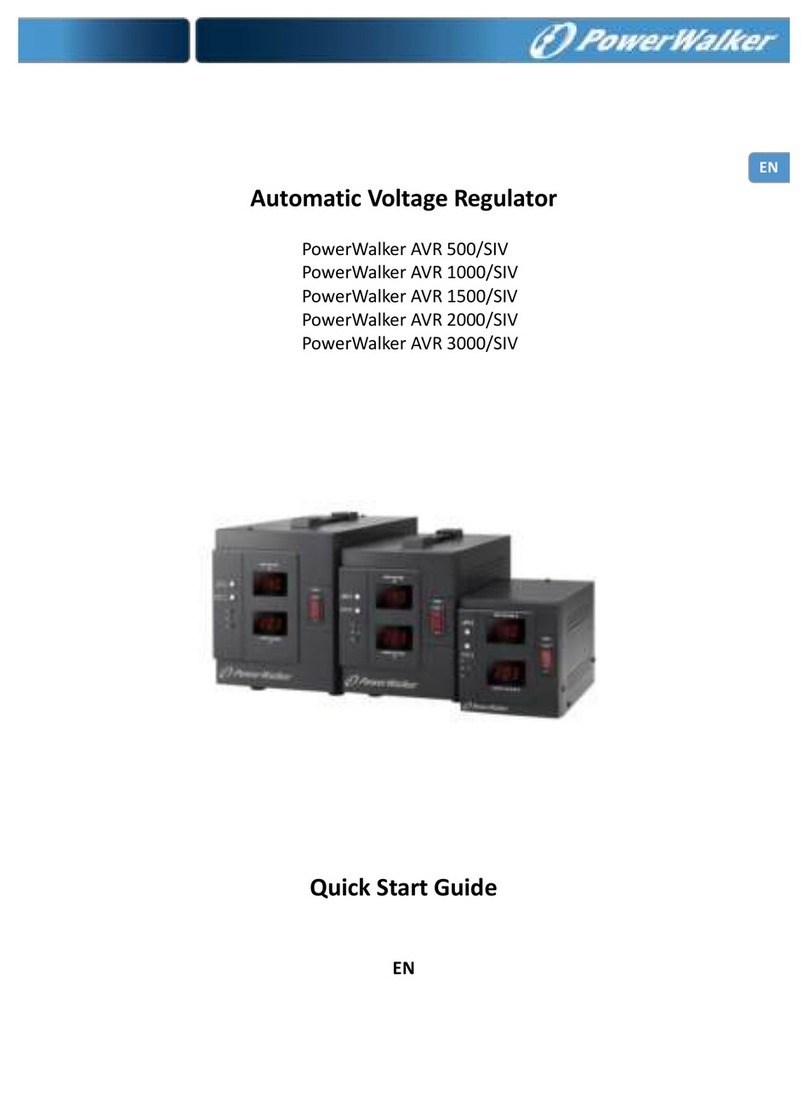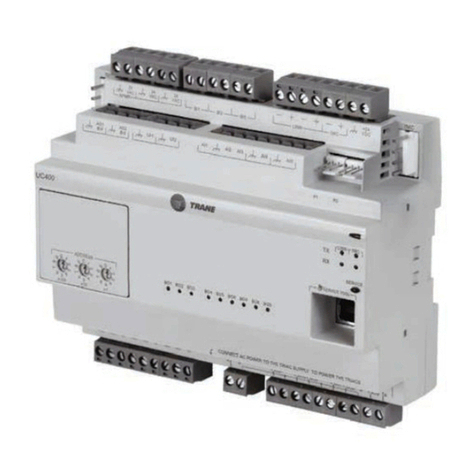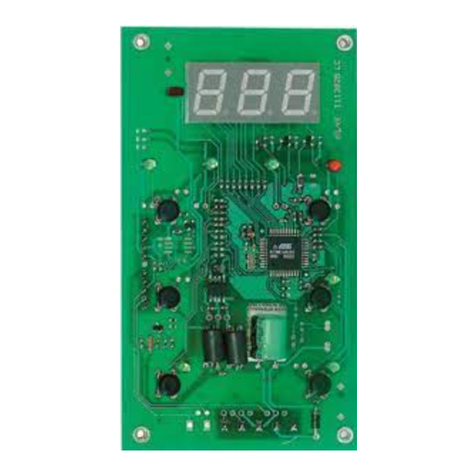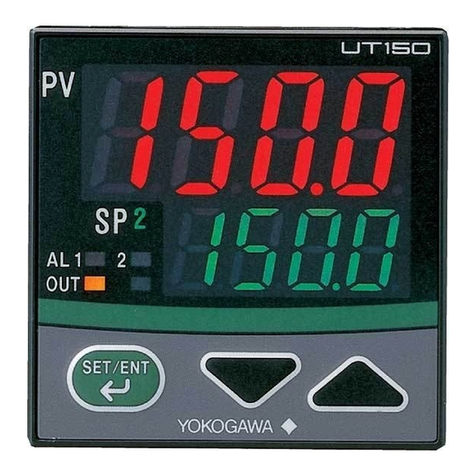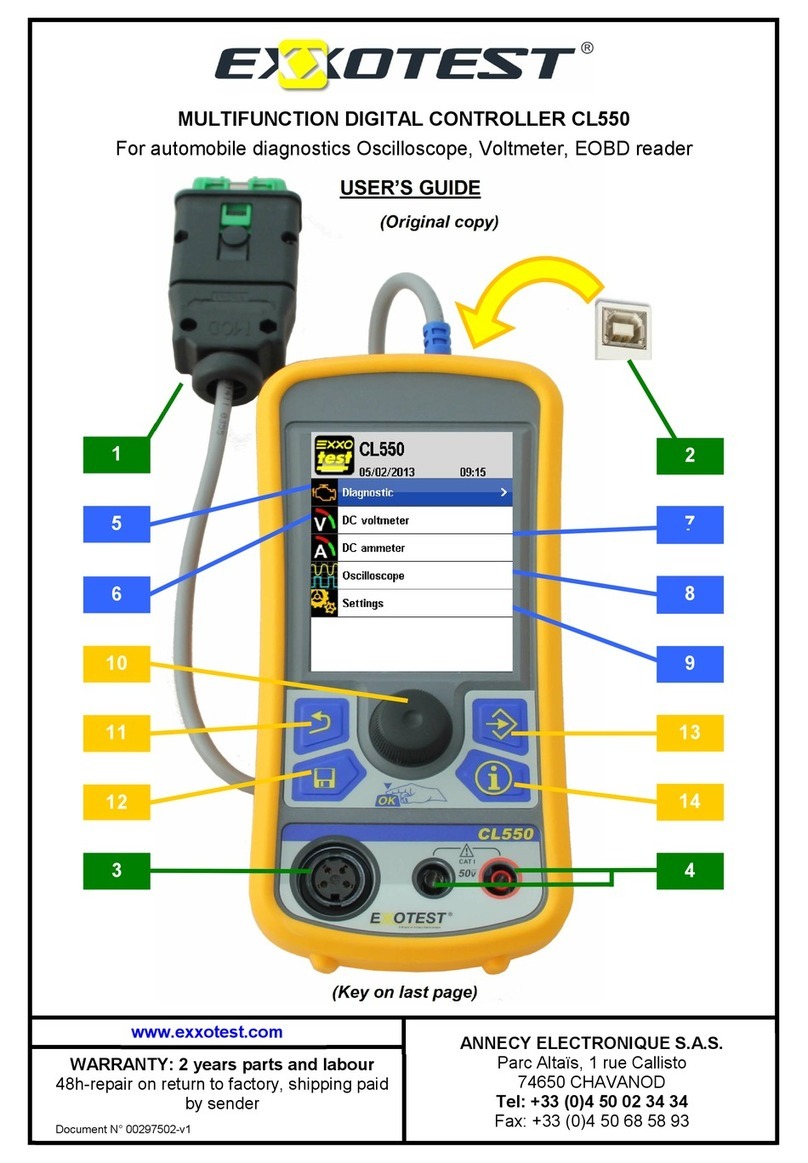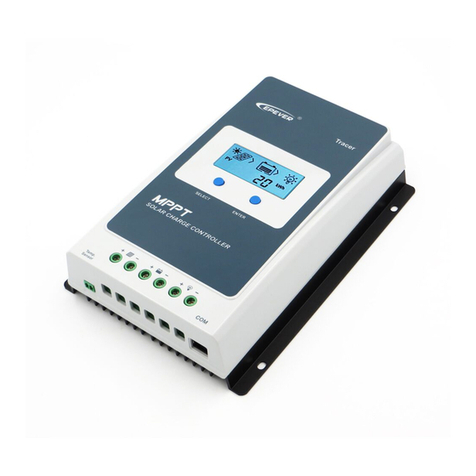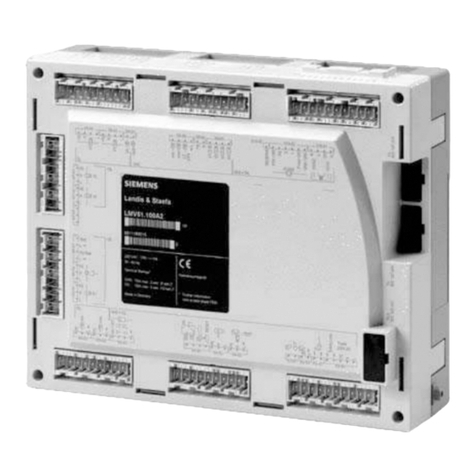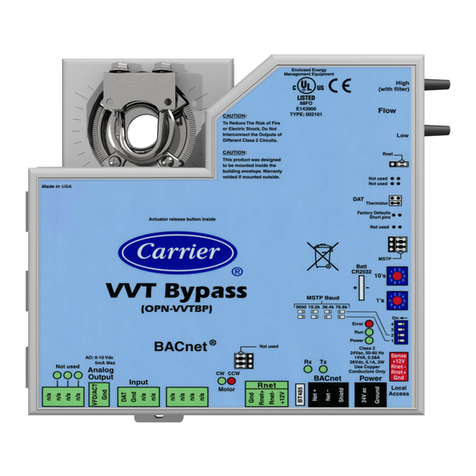Solcon RVS-AX0 User manual

Instruction Manual
Ver. 0519
Digital Soft Starter with internal ByPass
3.5-75A, 220 / 400 / 500V

2
RVS-AXO Instruction Manual
TABLE OF CONTENT
2.
Safety & Warning.......................................................................................3
2.1. Safety ............................................................................................3
2.2. Warnings ....................................................................................... 3
3.
Technical Data........................................................................................... 4
3.1
Introduction..................................................................................... 4
3.2
Rating and Frame Sizes..................................................................4
3.3
Ordering Information.......................................................................5
4.
RVS-AXO selection ...................................................................................6
5.
Recommended wiring schemes...............................................................6
5.1. Typical Wiring Diagram..................................................................6
5.2. Control supply (Terminals 1, 2)......................................................7
5.3. Start/Stop Input (Terminal 3)..........................................................7
5.4. Run contact (Terminals 4, 5) ......................................................... 7
5.5. Fault Contact (Terminals 6, 7)....................................................... 8
6.
Dimensions................................................................................................ 8
7.
Installation.................................................................................................9
7.1…………………………………………………………………..…….......9
7.2…………………………………………………………………….……….9
7.3………………………………………………………………..……………9
8.
Operation Interface ..............................................................10
8.1. Control........................................................................................... 10
8.2. Control Terminals..........................................................................10
8.3. User Interface.................................................................................11
9.
Protections ................................................................................................ 12
9.1. Protection List.................................................................................12
9.2. Faults Display.................................................................................13
9.3. Overload Trip Time.........................................................................13
10.
Setting parameters...................................................................................14
11.
Communication Manual........................................................................... 15

3
2. SAFETY & WARNINGS
2.1
Safety
1
Read this manual carefully before operating the equipment and follow its
instructions.
2
Installation, operation and maintenance should be in strict accordance
with this manual, national codes and good practice.
3
Installation or operation not performed in strict accordance with these
instructions will void manufacturer’s warranty.
4
Disconnect all power inputs before servicing the soft-starter and/or the
motor.
5
After installation, check and verify that no parts (bolts, washers, etc.)
have fallen into the starter.
6
During shipping, the soft-starter might have been roughly handled,
therefore, it is recommended to initialize the soft-starter by connecting
supply voltage prior to operating the soft-starter with a motor
2.2
Warnings
1
Internal components and P.C.Bs are at mains potential when the
RVS-AXO is connected to mains. This voltage is extremely dangerous
and will cause death or severe injury if contacted.
2
When RVS-AXO is connected to mains, even if start command has not
been issued and motor is stopped, full voltage may appear on starter’s
output and motor’s terminals.
Therefore, for isolation purposes it is required to connect an isolation
device upstream to the RVS-AXO.
3
The starter must be properly grounded to ensure correct operation, safety
and to prevent damage.
4
Check that Power Factor capacitors are not connected to the output side of the
soft starter.
5
Do not interchange line and load connections

4
T1
3. Technical data
3.1. Introduction
The RVS-AXO is a starter designed for use with standard three-phase, three-wire, squirrel
cage, induction motors.
It provides the best method of reducing current during motor starting.
The RVS-AXO starts the motor by supplying a slowly increasing voltage, providing soft start
and smooth acceleration, while drawing the minimum current necessary to start the motor.
U
Um Um –mains voltage
U0 –initial voltage
U0 T1 –voltage rise time
t
The RVS-AXO is equipped with internal by-pass controlled by its micro-controller. The by-pass
closes after the end of the starting process, thus reducing heating and saving power.
3.2 Rating and frames sizes
Frame
Starter
type
Starter
FLC
[A]
Dimensions
WxHxD
[mm]
Weight
[Kg]
A
RVS-AXO 3
3
175*92*95
0.8
RVS-AXO 4.5
4.5
175*92*95
0.8
RVS-AXO 7.5
7.5
175*92*95
0.8
RVS-AXO 11
11
175*92*95
0.8
B
RVS-AXO 15
15
200*108*105
1
RVS-AXO 22
22
200*108*105
1
C
RVS-AXO 30
30
222*125*132
2
RVS-AXO 37
37
222*125*132
2
RVS-AXO 45
45
222*125*132
2
RVS-AXO 60
60
222*125*132
2
RVS-AXO 75
75
222*125*132
2

5
3.3 Ordering Information
RVS-
AXO
3-
400-
230-
3M-
S
Full
load
Current
Mains
Voltage
Control
Voltage
Options
Front
Panel
Full load Current
Specify
Description
Starter’s
FLC [A]
3, 4.5, 7.5, 11, 15, 22, 30, 37, 45, 60, 75
Mains Voltage
Specify
Description
220
220 VAC, 50/60Hz , +10% -15%
400
400 VAC, 50/60Hz , +10% -15%
500
500 VAC, 50/60Hz , +10% -15%
Control Voltage
Specify
Description
230
100-240VAC, 50/60Hz , +10% -15%
Options
Specify
Description
0
No options
3M
Communication RS-485 Board (MODBUS)
Front Panel
Specify
Description
S
Standard lexan
Example:
RVS-AXO rated 22A, mains voltage 400V:
RVS-AXO 22- 400 –230 –3M-S

6
4. RVS-AXO selection.
Select RVS-AXO according to motor’s Full Load Ampere (FLA) - as indicated on its
nameplate (even if the motor will not be fully loaded).
RVS-AXO is designed to operate under the following maximum conditions:
Ambient
temperature ⁰C
Starting current
(A)
Acceleration
time(Sec)
Starts per hour
40
3 * In
7
6
When operating under ambient temperature higher than 40 ⁰C, RVS-AXO nominal current
decreases 0.8% / 1⁰C.
When operating at altitude above 1000m, RVS-AXO nominal current decreases 1% / 150m.
5. Recommended wiring schemes
5.1.
Typical wiring diagram

7
Notes:
(1) –Circuit breaker provides IEC type 1 coordination. Use fuses for IEC type 2
coordination. Refer to table below.
Model
SCR 𝒊𝟐∗ 𝒕(A^2 * sec)
Fuse value
RVS-AXO 3
270
10A
RVS-AXO 4.5
610
16A
RVS-AXO 7.5
1700
25A
RVS-AXO 11
3630
32A
RVS-AXO 15
6750
32A
RVS-AXO 22
14250
50A
RVS-AXO 30
27000
63A
RVS-AXO 37
41070
100A
RVS-AXO 45
60750
125A
RVS-AXO 60
108000
125A
RVS-AXO 75
168750
200A
5.2.
Control supply (Terminals 1, 2)
100-240VAC, 50/60Hz is required to power the electronic circuitry and the bypass.
5.3.
Start / Stop input (Terminal 3)
Close contact between 1 and 3 to soft start the motor.
To stop the motor open the contact. If deceleration time is set to 0 Sec, then the engine stops
in a minimum time, depending on own losses.
Commands to start / stop cam be send via Modbus communication channel as well.
5.4.
Run contact (Terminals 4, 5)
It is voltage free, N.O. 5A, 250Vac contact.
Via AXO Modbus communication channel we can select from two possibilities.
a.
Contact is closed immediately on getting Start command and stays closed until Stop
command. This is a factory setting.
b.
Contact is closed / opened synchronously with bypass.

8
5.5.
Fault contact (Terminals 6, 7)
It is voltage free, N.O. 5A, 250Vac contact.
Contact is closed when soft starter is in Trip state. To reset this state control voltage has to be
disconnected and then reconnected.
Trip reset can be done via Modbus communication channel as well.
6. Dimensions

9
7. Installation
7.1
Prior to Installation
Check that Motor’s Full Load Ampere (FLA) is lower than, or equal, to the starter’s Full Load
Current (FLC) and that Mains and Control voltages are as indicated on the starter’s side label.
7.2
Mounting
The starter must be mounted vertically. Allow sufficient space (at least 100mm) above and
below the starter for suitable airflow.
Do not mount the starter near heat sources.
Surrounding air temperature in the cabinet should not exceed 40ºC
Protect the starter from dust and corrosive atmospheres.
7.3
Power wiring instructions
Input power and output motor field wiring shall be copper conductors, rated 75ºC.
Minimal wire size, terminal screw and torque ratings for attachment to power inputs of RVS-
AXO are presented below.
RVS-AXO
Terminals Screw
Minimal wire size
(mm^2)
Mechanical Torque
(N*m)
RVS-AXO 3
M5
2.5
3
RVS-AXO 4.5
M5
2.5
3
RVS-AXO 7.5
M5
2.5
3
RVS-AXO 11
M5
2.5
3
RVS-AXO 15
M5
2.5
3
RVS-AXO 22
M5
4
5
RVS-AXO 30
M5
4
5
RVS-AXO 37
M5
6
5
RVS-AXO 45
M6
10
5
RVS-AXO 60
M6
16
5
RVS-AXO 75
M6
16
5

10
8. Operation Interface.
8.1. Control
- Initial voltage at Start and voltage rise (Start) / reduction time (Stop) set by 3 built-in
potentiometers or via Modbus communication channel.
-
Start / Stop command supplied by external voltage free contact or via
Modbus communication channel.
-
Fault reset can be done by switching control voltage OFF / ON or via
Modbus communication channel.
8.2. Control terminals
#
Name
Duty
1
L
Control voltage (100-240Vac) phase input
2
N
Control voltage neutral input
3
Start / Stop
Connect 100-240Vac related to N to start the motor.
Disconnect –to stop the motor.
4
Run relay NO
Closed in Start and Run or only Run state of the starter.
5
Run relay common
6
Fault relay NO
Closed in Fault state of the starter.
7
Fault relay common
8
RS485 A-Line (+)
RS485, Modbus communication port.
9
RS485 B-Line (-)
10
Ground

11
8.3. User interface
Potentiometers description:
Potentiometer
Duty
Set initial voltage to 30-70%.
Set voltage rise time to 1-30Sec.
Set voltage reduction time to 0-30Sec.

12
LEDs description:
LED
duty
Power
Lights when RVS-AXO energized
Run
Blinks at start / soft stop. Lights when
bypass is closed.
Fault 1
Blinks or lights when RVS-AXO is in fault
state.
Fault 2
9. Protections
9.1
Protections list:
Fault
Active at
Setting range
Factory set
Stop
Start
Soft
Stop
Bypass
Wrong phase
sequence
x
v
v
v
Enabled /
Disabled
Enabled
Phase loss / No
voltage
x
v
v
v
Max Start Time
x
v
x
x
0 –35Sec.
30Sec
Over current
instantaneous
v
v
v
v
850% FLA
850% FLA
Over current
delayed
v
v
v
v
200-600% FLA
with delay 0.1-
1Sec.
450%, 1Sec
Overload
x
x
x
v
Pickup 100-
200% FLA,
Grade 10A, 10,
20, 30
115%, 10A
Unbalance
X
X
X
v
10-50% of FLA,
0 –25Sec delay
30%, 10Sec
Over
Temperature
v
v
v
v
80⁰C (heat sink
temperature)
80⁰C
Note:
Factory settings can be changed via Modbus communication channel.

13
9.2
Faults display:
Fault
LED Fault 1
LED Fault 2
Wrong phase sequence
Blinks
Phase loss / No voltage
Blinks
Max Start Time
Blinks
Blinks
Over current
Lights
Overload
Lights
Blinks
Current unbalance
Lights
Over Temperature
Blinks
Lights
9.3
Overload trip time
Overload trip delay depends on motor initial state (cold / hot), motor current, selected overload
protection grade and selected overload protection pickup.
Delays for hot motor and selected pickup = 115% FLA are presented below:
Overload
grade
Motor current %FLA
800
700
600
500
400
300
200
10A
1.6Sec
2Sec
3Sec
4Sec
6Sec
12Sec
26Sec
10
3
4
6
8
13
23
52
20
5
6
9
12
19
35
78
30
7
9
13
19
29
52
112

14
10. Setting parameters.
Those parameters can be changed via Modbus communication channel.
Parameter
Setting range
Factory setting
Motor FLA
1-100A
According to RVS-AO model
Start parameters
setting
0 –by potentiometers
1 –by Modbus channel
0
Initial Voltage
at Start
1 –15 (1 ->30%, 15 ->70%)
Applicable when [Start parameters
setting] set to Modbus channel
Voltage rise time at
Start
1 –15 (1 ->1Sec, 15 ->
30Sec)
Voltage reduction
time at stop
1 –15 (1 ->0Sec, 15 ->
30Sec)
Current Limit
300- 500 %FLA
340%
Max Start Time
0-35 Sec.
30 Sec.
Over current trip
level
200-600%FLA
450%
Over current trip
delay
0 –2Sec
1 Sec
Overload protection
pickup
100 –200%FLA
115%
Overload protection
grade
0 –10A
1 –10
2 –20
3 - 30
10A
Phase sequence
protection
0 –OFF
1 - ON
ON
Modbus Address
1 - 127
1
Baud Rate
0 - 1200
1 –2400
2 –4800
3 –9600
4 - 19200
9600
Parity check
0 –Even
1 –Odd
2 - None
Even

15
11. RVS-AXO Instruction Manual
TABLE OF CONTENT
1. INTRODUCTION…......................................................................16
2. BASIC STRUCTURE OF THE SERIAL LINK FRAME ....................... 17
3. LIST OF FUNCTIONS SUPPORTED BY THE RVS-AXO ...................18
4. ACTUAL DATA (Input registers) ................................................. 19
5. SETTING PARAMETERS (Holding Registers) ................................21
6. DISCRETE COMMANDS .............................................................. 25
7. DIAGNOSTICS .............................................................................27

16
1. INTRODUCTION
This document summarizes the serial link protocol to / from the DIGITAL SOFT STARTER (RVS-AXO).
Features:
* RS485 Hardware.
* Asynchronous serial link.
* Half duplex.
* Format: Modbus RTU Mode (Remote Terminal Unit Mode).
- Binary,
- Each character includes 11 bits:
- 1 start bit
- 8 data bits, least significant bit sent first.
- 1 Parity bit. Even / Odd / No can be selected..
- 1 Stop bit if Parity is used, 2 stop bits if Parity is not used.
- Cyclical Redundancy Check (CRC), 16 bits.
* Baud Rates: 1200/2400/4800 / 9600/19200 bits per second..
* Response time of the RVS-AXO:
- Normally, 4ms <= time response <= 40mS.
- For a long response, time response <= 200mS.
* It is not recommended to transmit to theRVS-AXOtoo often, at afaster rate than once per second,
as it can slow down RVS-AXO time delays.
* After storing setting parameters, it is forbidden to transmit again to the same RVS-AXO in less
than 1 Sec.
* Broadcast commands: not supported.
Notes:
* It is recommended to connect 120 OHM resistors on both ends of the serial link.
* Turn off (and on again) control power after changing Baud Rate, Parity Check orSerial Link No (Slave
Address).
* It is a must to connect earth to the RVS-AXO earth terminal before connecting serial link wires.
Ignoring this instruction may result in permanent damage to the Serial Link Hardware.
* Being in Start / Soft Stop state RVS-AXO is busy controlling its SCRs and will not respond to
requests.

17
2. BASIC STRUCTURE OF THE SERIAL LINK FRAME
Modbus RTU frame have the same principal structure for both the "Query" transmission from the Master
to the Slave (RVS-AXO) and the Response transmission from the Slave to the Master.
"Sync":
Silent time of at least 3.5 character (3.5 *
11 bit times).
Byte 1:
Serial Link No. (= Slave Address)
(1...247)
Byte 2:
Function
(1, 2, 3,4,5,6,8,15 &16 are supported)
Byte 3:
Data Bytes
($XX)
.
.
($XX)
.
.
($XX)
Byte n-1: CRC_Low ($XX)
Byte n: CRC_High ($XX)
"Sync": Silent time of at least 3.5 character (3.5 * 11 bit times).
SYNC (Silent Interval)
In RTU mode messages “synchronize" by a "Silent Interval" of more than 3.5 character times. This silent
interval separates between transmission frames.
The entire frame must be transmitted as a continuous stream. A silent time of more than 3.5 character
times during frame transmission will cause the receiving device to ignore the incomplete frame. Next byte
will be assumed as the Serial Link No. of the next frame.
Same result of ignoring the frame can occur if a second message is transmitted before 3.5 character
times from the end of the previousone. This willcause the receiving device to consider it as acontinuation
of the first frame, resulting with CRC error.
SERIAL LINK NO. (SLAVE ADDRESS)
Contains RVS-AXO Slave Number (1-127) on theserial link. The RVS-AXO default value is 1. Serial Link
No. is used as the first byte in both the "Query" transmission from Master to Slave and in Response
transmission from Slave to Master.
FUNCTION
The Function code informs the RVS-AXO what is the requested action to take. In normal cases, Function
is used as the second byte in both the "Query" transmission from Master to Slave and in Response
transmission from Slave to Master.

18
3.LIST OF FUNCTIONS SUPPORTED BY THE RVS-AXO
Function Modbus Name Use in RVS-AXO
01
Read Coil Status
Read Discrete Commands status.
02
Read Input Status
Read Discrete Inputs status.
03
Read Holding Registers.
Read Setting Parameters.
04
Read Input Registers.
Read actual data.
05
Force Single Coil.
Force one discrete command.
06
Preset Single Register.
Write one setting parameter.
08
Diagnostics.
Loopback Diagnostics.
15
Force Multiple Coils.
Force Discrete Commands.
16
DATA
Force Multiple Registers
Write Setting Parameters
Control Commands
Data field includes information transferred to and from the RVS-AXO. The specific dataformat is changed
with Function. When Word data parameters are transmitted, High Byte is transmitted first, followed by
the Low Byte.
CRC
The CRC (Cyclic Redundancy Check) two bytes (16 bit) are used to check the entire frame bytes.
It is generated in the master device and transmitted as the last two bytes of the frame (Low byte is
appended first followed by the High byte). The slave device generates the CRC bytes again and
compares it to the received CRC bytes. If the CRC bytes are not identical, the frame is flushed and no
response is transmitted to the master.

19
4. ACTUAL DATA (Input registers)
Actual data includes measured values such as currents and mains frequency. It includes also logic
information aswell as statistic information. All parameters are word (two bytes) parameters. The protocol
supports only Reading of these parameters.
Address
Register
Range / Unit
Note
0
Phase L1 current
%FLA
1
Phase L2 current
%FLA
2
Phase L3 current
%FLA
3
Initial Voltage
0...512 (0~70%, 512~30%)
Represent
potentiometers state.
4
Voltage rise time at start
0..512 (0~30, 512~1 Sec)
5
Voltage reduction time
0…512(0~30,512~0 Sec)
6
Average current
%FLA
7
Mains Frequency
Hz
8
RVX-AXO status
1~Stop, 129~Fault,
9
Hardwire inputs
0~ Start / Stop open, 1~
Start / Stop closed
10
Fault status
Code-2 of active fault. See
faults list below.
11
Accumulated running
time
Hours
12
Accumulated running
time
Tenth of a second.
13
Number of starts
14
Number of faults
15
Reserved
16
Code-1 of 10 last faults.

20
Faults list:
Fault
Code-1
Code-2
Over temperature
1
1
Phase loss/ no voltage
2
2
Over current
3
4
Over load
4
8
Current unbalance
5
16
Negative phase sequence
6
32
Example 1:
Toreadinputregistersataddresses0…2 (Phasecurrents I1, I2, I3) of RVS-AXO#18thehost computer
should send following frame:
Byte 1:
Serial Link No.
($12)
Byte 2:
Function
($04)
Byte 3:
Starting Address High
($00)
Byte 4:
Starting Address Low
($00)
Byte 5:
No. of Points High
($00)
Byte 6:
No. of Points Low
($03)
Byte 7:
CRC_Low
($XX)
Byte 8:
CRC_High
($XX)
The RVS-AXO response, when Current = 80, 81, 82 % FLA, is:
Byte 1:
Serial Link No.
($12)
Byte 2:
Function
($04)
Byte 3:
Byte Count
($06)
Byte 4:
Data High, I1
($00)
Byte 5:
Data Low, I1
($50)
Byte 4:
Data High, I2
($00)
Byte 5:
Data Low, I2
($51)
Byte 6:
Data High, I3
($00)
Byte 7:
Data Low, I3
($52)
Byte 8:
CRC_Low
($XX)
Byte 9:
CRC_High
($XX)
Note: $XX indicates Hexadecimal byte.
This manual suits for next models
9
Table of contents
Other Solcon Controllers manuals
Popular Controllers manuals by other brands
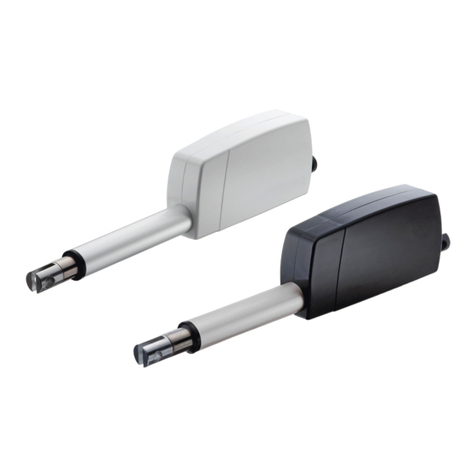
THOMSON
THOMSON WhisperTrak installation manual
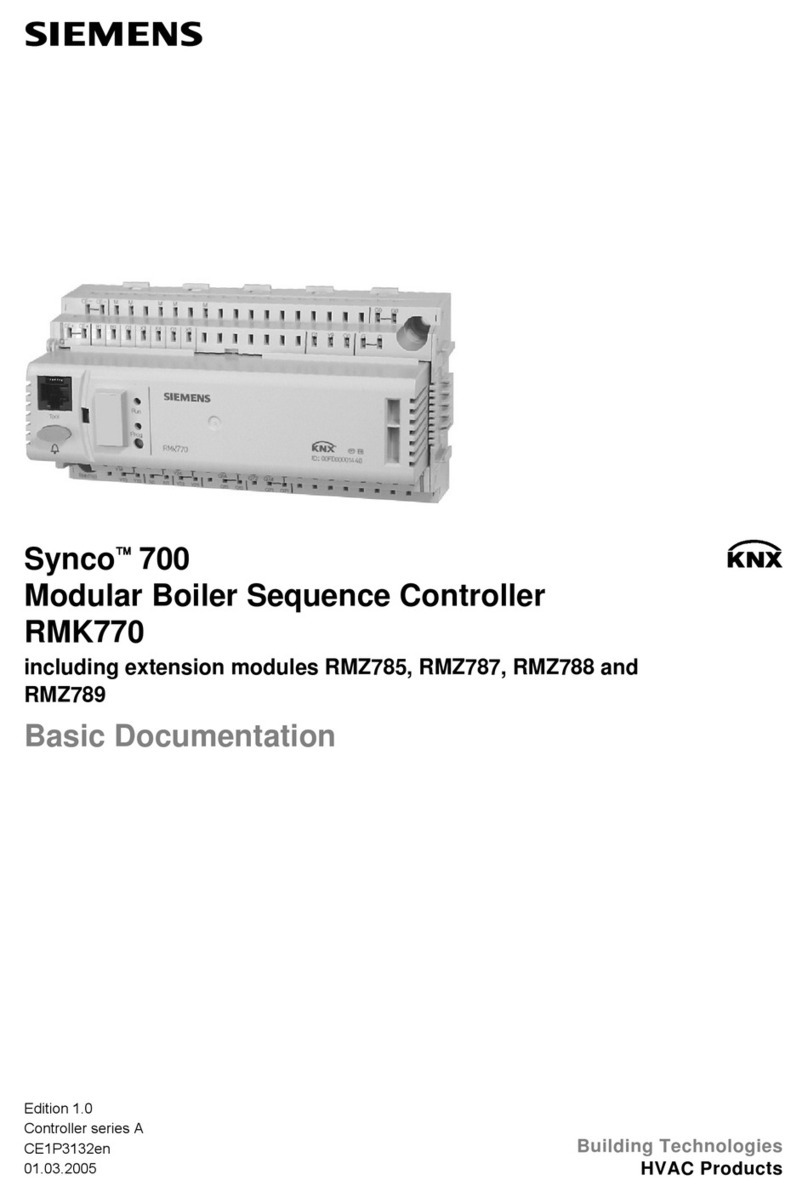
Siemens
Siemens Synco700 RMK770 Documentation handbook

Profire Energy
Profire Energy PF3100 Series Software setup guide
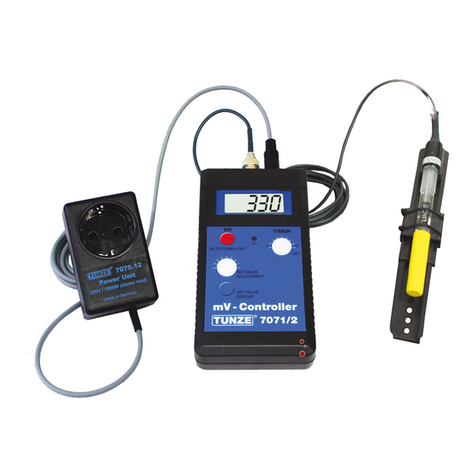
Tunze
Tunze 7074/2 Instructions for use
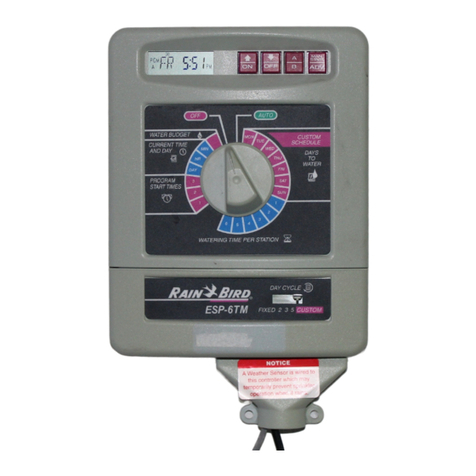
Rain Bird
Rain Bird ESP-TM Series Installation, Programming, & Operation

RNA
RNA ESK 2001 operating instructions
